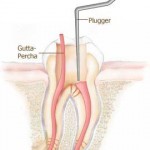 Sealing the root canal system with a proper filling material is an important step in determining the success of root canal treatment. This is known as obturation which is done to prevent reinfection of microorganisms into the root canal system.
Sealing the root canal system with a proper filling material is an important step in determining the success of root canal treatment. This is known as obturation which is done to prevent reinfection of microorganisms into the root canal system.
What materials does a dentist use to obturate/seal your root canal?
Obturating materials can come in solid or semisolid form (paste). Gutta percha is an example of solid obturating material. Most dentists prefer to use gutta percha as a root filling material because of its self sterilizing ability and they are easier to manage in terms of placing and removing them from the root canal. If you have seen your dentist coating the gutta percha points with a type of viscous material, that material is known as root canal sealer. Sealer is important to provide a tight seal of the root canal to prevent bacteria from reentering the root canal system. Resin based and zinc oxide eugenol sealers are commonly used by dentists.
Obturation techniques
This article will explain in depth the common obturation techniques used by most dentists during root canal treatment.
Lateral compaction technique
This technique can be used in most cases except in situations such as severely curved canals and root canals with gross irregularities. It is a simple method which allows your dentist to have control of the gutta percha point. The gutta percha point should terminate around 0.5mm of the working length (length of your root). This can be confirmed by using dental radiographic image.
Obturation is performed after your dentist has done the root canal cleaning process. He will then choose a master cone (the main gutta percha point) and insert it into your nicely tapered root canal. It should give the dentist a tug back feeling which indicates that the gutta percha point is fitted properly inside your root canal. After that, he will apply some sealer on your root canal walls , followed by inserting the master cone into the canal. An instrument which is known as spreader will be inserted into the canal wall so that the gutta percha points can be laterally compacted against the root canal walls. Accessory cones ( extra smaller gutta points ) will be placed to fill the remaining root canal space. Lastly your dentist will heat an instrument and compact the gutta percha points as well as to remove the excess obturating material.
Vertical compaction technique
Vertical compaction technique is also another effective obturation technique. It is often used by dentist because of its ability to adapt to the irregularities of your root canal system. However, it can be difficult for your dentist to control the gutta percha length. Overfilling or underfilling of your root canal system can cause failure of a root canal treatment. This technique involves placing a gutta percha point that ends approximately 0.5mm of the working length, then your dentist will heat to soften the gutta percha point.After that,he will place an instrument to apply pressure so that the gutta percha will adapt nicely to your root canal system. Additional obturating material will be added in small increments until the entire canal is filled.
Other obturation techniques:
Thermoplasticized injection: Obturation is done by injecting specially formulated gutta percha into the canals
Solvent techniques: Dissolve gutta percha using solvents such as chloroform.
Carrier based technique:  Obturation is done by warming a plastic carrier which is coated with gutta percha and deliver it into root canal as a root canal filling.
Best way to evaluate the quality of root filling is through dental radiographic image. An ideal root filling should reach the working length and completely fill the root canal space (uniform density) Follow up after root canal treatment is usually done after 3 to 6 months to evaluate the outcome of the treatment.  A root canal treatment is considered a complete success when there is absence of signs and symptoms (pain and swelling), disappearance of sinus tract, no evidence of soft tissue destruction and no significant radiographic findings.
Read here for more information regarding the entire root canal treatment procedure:
http://www.intelligentdental.com/2011/07/17/dental-root-canal-procedures/
Amazing website! I love all the information I have found here. Thank you for taking the time to explain dental conditions and procedures.
thanks !!!
Thanks for a very impormative topic about rct-obturation proc..